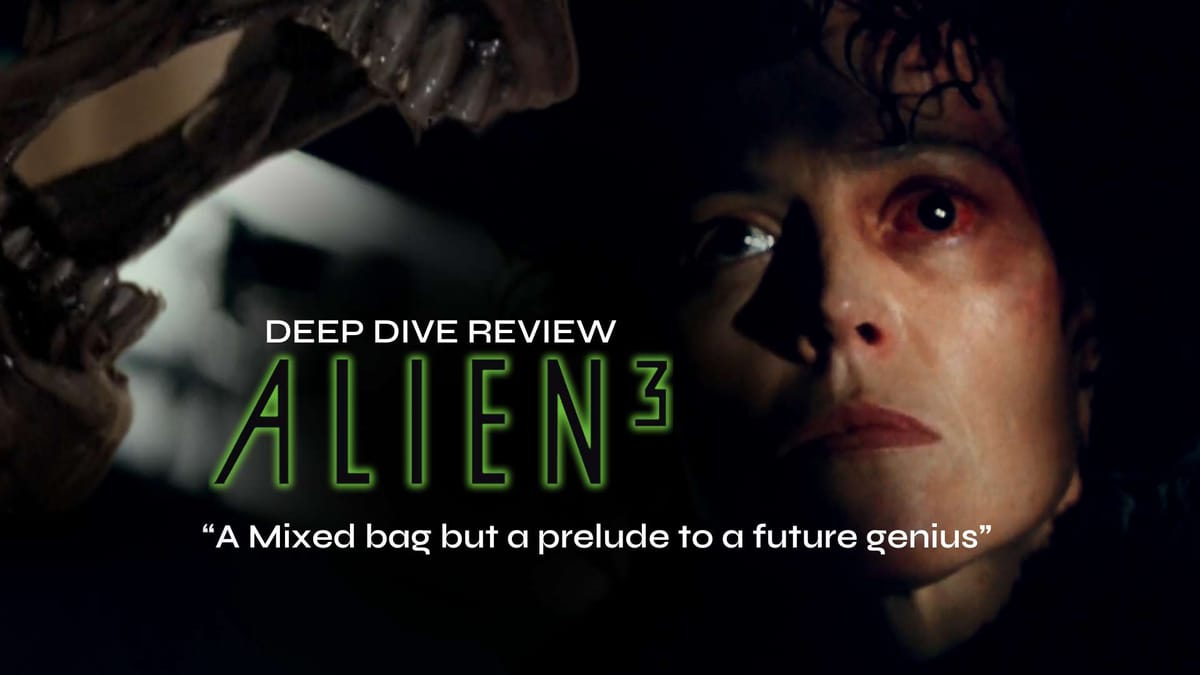Deep Dive: Alien 3 - A Complex Legacy of Ambition and Controversy
Join us as we examine Alien 3 in detail, exploring its themes, production context, and reception. From its place in the Alien franchise to its reflection of socio-political issues of the time, we'll investigate whether this film deserves a reassessment.

Here at Rewind Zone, we believe that every film is a tapestry of meanings, intentions, and cultural reflections. Our mission is to peel back these layers, offering insights and explanations that may not be immediately apparent to the viewer. We dive deep into the heart of cinema, exploring the nuances that make each film a unique piece of art and social commentary.
Today, we turn our analytical lens to the 1992 film Alien 3, directed by David Fincher in his feature film directorial debut (a huge undertaking considering he was predominantly known for Directing Music Videos!). This movie, often dismissed by critics and fans of the franchise, raises several questions: Was its meaning lost amidst the controversy? Did it offer more substance than its detractors claimed? Was there a deeper social commentary hidden beneath its grim surface?
Trailer:
The Alien Franchise: Setting the Stage
Before delving into Alien 3, it's crucial to understand its predecessors and the expectations they set for the franchise.
Alien (1979)
Directed by Ridley Scott, Alien introduced audiences to a new kind of sci-fi horror. Set in the claustrophobic confines of the spaceship Nostromo, it blended suspense, horror, and groundbreaking visual design to create a truly terrifying experience.
Key elements:
- Slow-burn horror and suspense
- Claustrophobic setting
- Strong female lead in Ellen Ripley
- Biomechanical creature design by H.R. Giger
Aliens (1986)
James Cameron's sequel took a different approach, transforming the franchise into an action-packed sci-fi adventure. While retaining elements of horror, Aliens expanded the universe and upped the stakes.
Key elements:
- Action-oriented plot
- Expanded lore (Queen Alien, more creatures)
- Military themes and characters
- Ripley as an action hero and surrogate mother
David Fincher's Approach: Why did he mess with a winning formula?
In his directorial debut, David Fincher took Alien 3 in a drastically different direction from its predecessors. To understand why Fincher decided to change the winning formula of the Alien franchise, we need to consider the shifting cinematic landscape of the early 1990s and the tumultuous production process:
Alien 3 had a notoriously troubled production, ranking alongside films like Apocalypse Now and World War Z in terms of behind-the-scenes challenges. The project spent years in development hell before Fincher was brought on board. He faced numerous obstacles, including an incomplete script, creative disagreements, and various production hassles that made the project seem cursed from the start.
The Assembly Cut of Alien 3 reveals that even the film's ending had to be changed at the last minute due to a rival blockbuster, further highlighting the difficulties Fincher faced in realizing his vision for the film. These production troubles likely contributed to the film's critical and commercial disappointment upon its initial release.
Despite these challenges, Fincher's attempt to take the franchise in a new direction was bold, if divisive. The film has undergone some critical reevaluation over the years, with the Assembly Cut offering a glimpse into what might have been had the production been smoother.
Fincher's inexperience as a feature film director, combined with the immense pressure of helming a beloved franchise and the numerous production issues, resulted in a film that, while ambitious, struggled to find its footing within the Alien series.
Fincher's Approach to Alien 3
Fincher's decision to change the franchise's formula was likely influenced by several factors in the evolving film industry:
Visual Style
Fincher introduced a gritty, industrial aesthetic that would become a hallmark of his later work, aligning with the growing trend of visually distinctive, auteur-driven films.
Psychological Focus
The film delved deeper into psychological horror and existential themes, reflecting a broader trend towards more complex, character-driven narratives.
Religious Undertones
Fincher incorporated religious symbolism and themes of redemption, adding depth to the narrative and aligning with the increasing genre-blending of the time.
Character Dynamics
The focus shifted to exploring complex character relationships within the prison setting, resonating with the growing appetite for nuanced storytelling.
Narrative Risks
Fincher made bold, controversial narrative choices, aligning with the emerging indie film movement challenging Hollywood conventions.
Rise of CGI
While other films pushed CGI boundaries, Fincher relied more on practical effects and atmosphere, perhaps as a deliberate counter to this trend.
Indie Revolution
Fincher's darker, more ambiguous approach can be seen as an attempt to bring indie sensibility to a major franchise.
Blockbuster Fatigue
Fincher's psychological approach responded to growing appreciation for films offering more than just spectacle.
Auteur Resurgence
As a new director, Fincher likely saw Alien 3 as an opportunity to establish his unique voice within a well-known franchise.
Franchise Expectations
Fincher's radical departure from the established Alien formula can be seen as an attempt to revitalize the franchise and subvert audience expectations.
By changing the winning formula, Fincher was taking a significant risk. However, this risk was calculated against the backdrop of a changing cinematic landscape that was increasingly rewarding innovation and auteur-driven storytelling. While the reception of Alien 3 was mixed, Fincher's bold approach foreshadowed his future success as a director known for his distinctive style and willingness to challenge audience expectations.
Gallery:









Alien 3 Timeline Gallery: Alien Ripley Underwear









Alien 3 Timeline Gallery
Franchise Comparison: Budget and Box Office
To better understand Alien 3's place in the franchise, let's compare the first three films:
Alien Franchise Financial Comparison
Alien (1979)
Budget: $11M ($41.7M)
Box Office: $104.9M ($397.6M)
Profit: $93.9M ($355.9M)
Aliens (1986)
Budget: $18.5M ($46.4M)
Box Office: $131.1M ($328.8M)
Profit: $112.6M ($282.4M)
Alien 3 (1992)
Budget: $50M ($98.1M)
Box Office: $159.8M ($313.6M)
Profit: $109.8M ($215.5M)
* Inflation-adjusted figures (in parentheses) are calculated based on 2024 USD values.
This chart illustrates several key points:
- Budget Escalation: Alien 3's budget was significantly higher than its predecessors, even when adjusted for inflation, reflecting the franchise's growing ambition and the increasing scale of production.
- Box Office Performance: Despite mixed reviews, Alien 3's box office performance was relatively strong, but it actually underperformed the original Alien when adjusted for inflation. This suggests a decline in audience engagement or increased competition in the market.
- Diminishing Returns: Alien 3 showed significant diminishing returns. Its inflation-adjusted profit was substantially lower than both of its predecessors, despite the increased budget. This likely contributed to studio disappointment and influenced future franchise decisions.
- Franchise Evolution: The increasing budgets, even when adjusted for inflation, reflect the franchise's evolution from a modest horror film to a major Hollywood property. However, this evolution came with increased financial risks and expectations.
- Impact of Inflation: The inflation-adjusted figures reveal that the original Alien was the most financially successful of the three, highlighting the challenge sequels face in matching the success of beloved originals.
Understanding Fincher's Deeper Process
Themes and Meaning of Alien 3
Symbolism and Existential Questions
Alien 3 delves deep into the nature of humanity, exploring what truly separates us from beasts driven purely by instinct. The film's rich symbolism and profound existential questions are often overlooked, adding layers of depth to what might otherwise be seen as a straightforward monster movie.
The Alien as Biblical Evil, representing primitive, destructive instincts.
Redemption Through Sacrifice, as convicts rise above their pasts.
Soul vs. Survival, questioning what makes humans different from the alien.
Faith and Religion
Alien 3 incorporates strong religious undertones, with the prison colony embracing a form of apocalyptic Christianity. Religious imagery and references permeate the film, creating a recurring motif of conflict between faith and harsh reality.
Corporate Power and Institutional Corruption
The film offers a scathing critique of unchecked corporate power. The Weyland-Yutani Corporation's relentless pursuit of the Alien represents unbridled corporate greed, while the prison system is portrayed as a failed institution. Through these elements, Alien 3 explores the expendability of human life in the face of corporate interests.
Alien 3 examines how individuals maintain (or lose) their humanity in a dehumanizing environment. The prisoners' journey from initial hostility to cooperation in the face of a common threat highlights the complexity of human nature in extreme circumstances.
The Role of the "Other"
The Alien serves as a powerful metaphor for the "Other" in society. Its presence forces the humans to confront their own nature and societal structures. The fear and unity created by the Alien's threat mirror real-world societal responses to perceived external threats, adding a layer of social commentary to the film.
Cinematography and Visual Style
Alien 3 marks the beginning of David Fincher's distinctive visual style, which would later become his trademark in films like Se7en and Fight Club. The film's unique visual look, characterized by its gritty, industrial aesthetics, was a glimpse into Fincher's future work.
Low camera angles, stark lighting, and filtered colors create a claustrophobic and oppressive atmosphere. The bleak, monochromatic setting of Fiorina 161 reflects the hopelessness of the characters' situation. While the CGI work on the alien was criticized, especially by today's standards, the overall visual design of the film remains one of its strongest aspects.

Critical Reception and Legacy of Alien 3
Alien 3's release in 1992 was met with mixed reviews, sparking ongoing debates among fans and critics. The film's bold risks, including its psychological horror approach, controversial character deaths, and bleak tone, were admired by some but criticized by others.
Key Controversies
The death of beloved characters Newt and Hicks at the film's outset was particularly contentious. While it set a desperate tone, many fans found it hard to accept. New characters like Clemens were praised for depth but criticized for being underutilized.
The film's execution was often seen as falling short of its ambitious concepts. Narrative disjointedness and pacing issues, likely results of the troubled production, left many feeling the film didn't reach its full potential.
Franchise Context
Alien 3's reception was significantly influenced by its position in the franchise. Following the action-packed Aliens, the return to a claustrophobic, horror-oriented approach disappointed some viewers while others appreciated the new direction.
If you are enjoying this, check out some other Deep Dives:


Final Thoughts
Alien 3 was a significant departure from its predecessors, losing much of what made the franchise iconic. While the poor CGI can be understood given the era's limitations, the stark contrast with the animatronic work was jarring.
The film's ending, reminiscent of Terminator 2, lacked originality. Although, granted, in Alien 3's theatrical release, the Alien Queen embryo bursts out of Ripley's chest, trying to escape its impending demise. With an almost serene look, the dying Ripley just holds onto the writhing creature as they fall into the vat.
David Fincher's inexperience as a director is evident, despite his attempt to bring a new vision to the franchise. Should he have changed the formula? Try and place the film as a standalone entry, and then decide how Fincher did.
While Alien 3 cannot be considered a complete flop, it ultimately fails to fit comfortably within the Alien series. It serves as an interesting, if flawed, experiment in the franchise's evolution.
Our Verdict






Comments ()